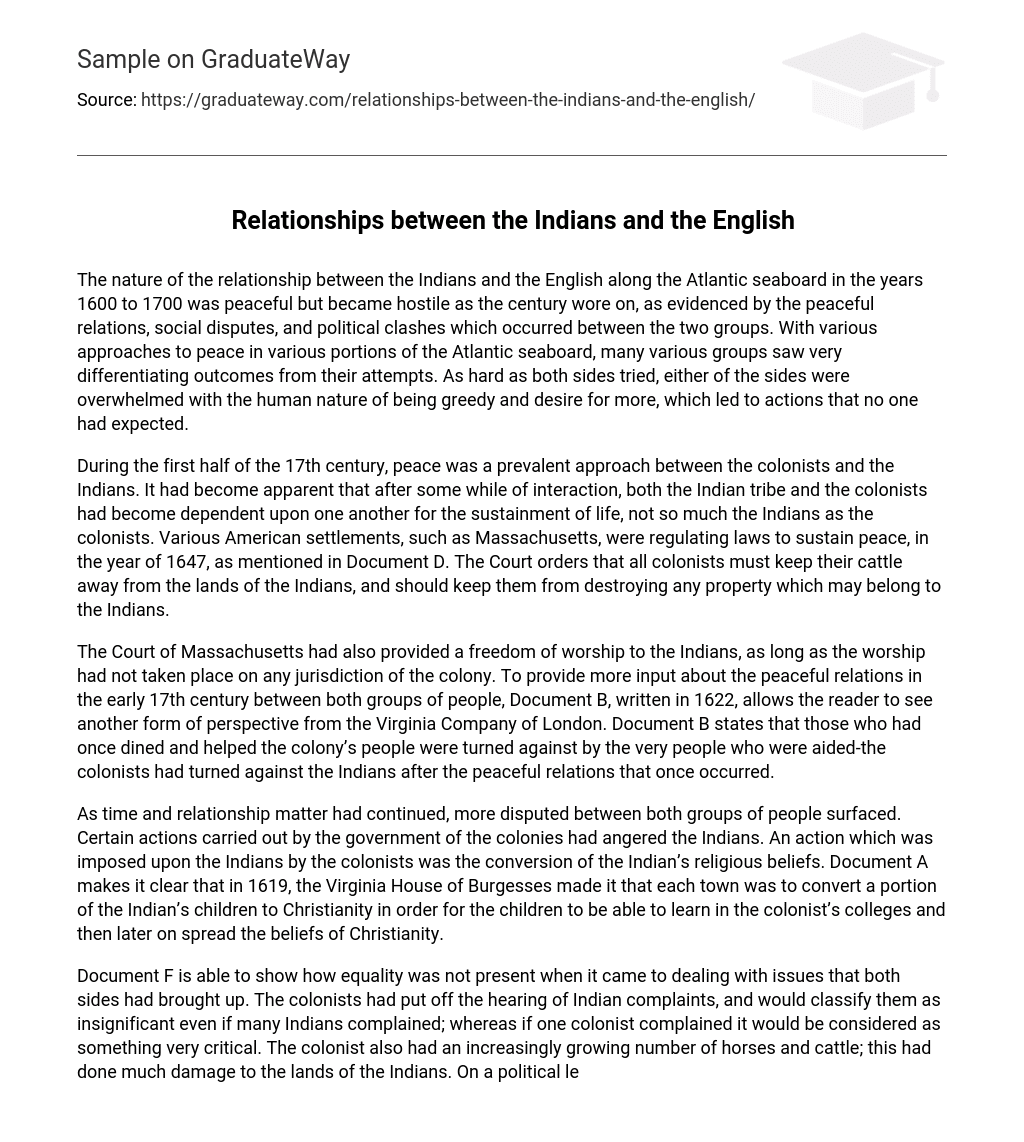The nature of the relationship between the Indians and the English on the Atlantic seaboard from 1600 to 1700 started out peacefully but grew hostile over time. This is apparent in the peaceful relations, social disputes, and political clashes that took place between the two groups. Different regions along the seaboard had various approaches to maintaining peace, resulting in diverse outcomes. Despite both sides’ efforts, human greed and desire for more ultimately led to unexpected actions.
During the early 17th century, a peaceful coexistence between the colonists and the Indians was prevalent. Both groups relied on each other for survival, with the colonists being more dependent on the Indians. In Massachusetts, laws were implemented in 1647 to ensure this peace. As stated in Document D, the court required colonists to keep their cattle away from Indian lands and avoid damaging any Indian property.
The Massachusetts Court granted Indians the freedom to worship, as long as it was not done within the colony’s jurisdiction. Document B, written in 1622 by the Virginia Company of London, further illustrates the harmonious relationship between the two groups in the early 17th century. It reveals that the colonists turned against the Indians who had previously assisted and shared meals with them after the peaceful relations no longer existed.
As time went on, more disagreements between the two groups of people arose. The actions taken by the colonial government had upset the Indians. One particular action forced upon the Indians by the colonists was the conversion of their religious beliefs. Document A reveals that in 1619, the Virginia House of Burgesses decreed that each town should convert some of the Indian children to Christianity so they could receive an education in the colonists’ colleges and subsequently promote the Christian faith.
Document F illustrates the lack of equality in addressing the concerns raised by both sides. The colonists disregarded Indian complaints, deeming them insignificant despite numerous Indian voices being raised, while attaching greater significance to complaints from a single colonist. Furthermore, the colonists’ rapidly expanding herds of horses and cattle caused considerable harm to Indian lands. Political conflicts between the Indians and colonists were also evident, with both sides experiencing both favorable and unfavorable circumstances.
The information presented in Document G highlights the positive outcome for the Indians after receiving rights from Governor Berkley through secret trades. This event took place in 1677 while other conflicts were happening on the Atlantic coast. Document H consists of a treaty between the colonists and Indians aimed at fighting against the French. It includes a portion of the treaty proposal from 1689 where the colonists sought assistance from the Indians. Document D reveals the presence of trade limitations with the Indians, which were deemed illegal to avoid any potential violence, and non-compliance resulted in fines.
Document E illustrates the strategies employed by the Indians to assert their rights, leading to the outbreak of King Phillip’s War. The war arose due to the English colonists’ unjustifiable dominance over the Pokunoket Native Indian group, despite initial harmonious relations. Additionally, the English colonists violated their agreement by selling Indian lands. Consequently, the Indians decided to rebel against these injustices and resort to armed conflict.
Following the war, King Phillip’s followers sought refuge in Canada to evade capture, while those who were unable to flee faced enslavement in the West Indies. The remaining inhabitants of the region encountered servitude, the imposition of a foreign culture, illnesses, and the dispossession of their land.
According to the documented evidence, the relationship between the Indians and the English on the Atlantic seaboard from 1600 to 1700 started peacefully. However, as the century progressed, it became increasingly hostile. This can be observed through the peaceful interactions, social conflicts, and political confrontations between the two groups. While there were numerous attempts and different viewpoints to reach agreements, encounters along the Atlantic coast revealed that initially peaceful relations eventually turned destructive in certain areas.





